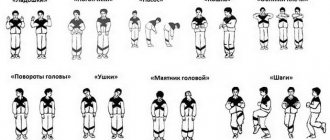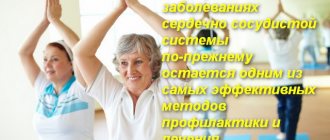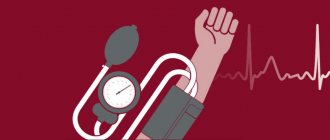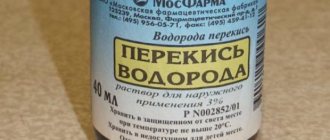Hypertension is a very common disease today. Often patients think that it cannot be cured.
However, there are some remedies that are not related to drug treatment, but they significantly improve the patient’s condition.
This applies to sets of exercises. It remains only to understand how effective gymnastics is for hypertension, and who it is suitable for.
Briefly about hypertension
Hypertension has characteristic symptoms. Hypertension is characterized by a constant increase in blood pressure above 140/90 mmHg. Art.
There are 2 types of disease. The following classification of hypertension is known:
- symptomatic;
- essential.
With symptomatic hypertension, the cause of the disease is expressed in disease of an internal organ (for example, the liver or kidneys). In the second case, the cause of the disease cannot be determined.
Treating symptomatic hypertension is not too difficult. The main task is to get rid of the original source, that is, to cure the problem organ. With essential hypertension, everything is more complicated.
Since it is unknown why it occurs, it is not possible to prescribe effective treatment (although most hypertensive patients suffer from this type of disease).
Treating hypertension with exercise
Treatment of hypertension is most often limited to taking medications.
But few people know about other treatment methods. Physical exercise is considered the most effective.
Benefits of physical activity
Some people suffering from hypertension lead a sedentary lifestyle, thinking that exercise is contraindicated if they have hypertension.
As practice shows, even slow walks reduce the risk of developing the disease. According to research, minimal physical activity already lowers blood pressure.
Therefore, doctors specially develop exercises for hypertensive patients. And sometimes you can even lower your blood pressure by learning to control your breathing.
The main rule is regularity of classes. This helps reduce stress on the heart. With regular exercise, improvements will appear within six months. This also applies to people over 50 years of age.
What physical exercises can you do?
The best option is cardio exercise. Strength exercises are strictly contraindicated for hypertension. They lead to increased blood pressure.
Also, the patient is excluded from excessively intense training and heavy lifting. Strength exercises are the use of sports equipment.
Patients can do exercises at home. The simplest cardio exercise is walking. And you don’t need to invent something - regular walking will do.
Benefit
Hypertension requires treatment. Medicines help restore normal blood pressure levels. Various physiotherapeutic measures help maintain it in normal condition. These include physical education classes. For patients with hypertension, special exercises have been selected that improve their overall well-being and prevent the occurrence of repeated changes in blood pressure. Exercise therapy is intended directly to restore and normalize the activity of the cardiovascular and other systems, the functioning of which has failed for a number of reasons.
Therapeutic gymnastics simultaneously performs several important functions:
- Strengthening blood vessels;
- Strengthening the immune system;
- Enrichment of blood with oxygen;
- Normalization of the blood circulation process;
- Eliminating excess weight problems;
- Improved mood.
Experts recommend combining physical exercises with breathing exercises. It is thanks to it that the blood is saturated with a sufficient amount of oxygen, which is necessary for the tissues of internal organs and other structures.
Exercise therapy and simple exercises for hypertensive patients
For hypertension, exercise therapy is selected individually for each patient. This depends on the severity of the disease. The main thing remains common to all patients: they are prohibited from overexerting themselves (for example, they cannot participate in a marathon). It is also contraindicated to exercise at too low or high temperatures.
The objectives of exercise therapy for hypertension are to strengthen the patient’s body. Here are examples of exercise therapy exercises that are suitable for hypertensive patients:
Raising arms and legs
Take a step with your right foot to the right while raising your arms. Return to the starting position, lowering your arms.
Do the same on the left side. Repeat several times.
Shin entanglement
Starting position – legs wider than shoulders, arms at chest level, elbows bent. First, the right shin is pulled back, and at the same time the elbows are raised.
Then - return to the starting position. Do the same with your left shin.
Knee lift
Alternately lift your right and left knees to your chest. You can make the exercise more difficult.
Starting position – feet shoulder-width apart, arms raised up, palms clenched into fists. Simultaneously with raising the knee, the arms bent at the elbows are lowered.
Return to starting position.
Knee pull-up
Starting position – the right leg is laid back. First, the right knee is pulled towards the chest.
Return to starting position. Do this several times, then repeat the exercise, changing your leg.
Kick
Starting position – hands on the belt, feet shoulder-width apart. A forward kick is made with the right foot, after which the leg is sent back.
Then the same kick is made with the left foot, after which the other leg is pulled back. Repeat the exercise several times separately with the right and left.
Walking in plank
Bend forward and touch the floor. Then move your arms forward until you are in a plank position.
After pausing for a few seconds, return to I.p.
Plank leg raises
Starting position – standing in a plank position. Move your right leg to the right, then return to the starting position. Do the same with the left. Repeat several times.
The patient can come up with his own pressure exercise. His imagination is not limited here. The main thing is to comply with the conditions of exercise therapy for hypertension, i.e., the exercises should be simple. The most effective exercises are those performed in the plank.
The described treatment complex is suitable not only for treatment, but also for prevention.
Set of exercises
When compiling a therapeutic set of exercises, attention must be paid to the stage of development of hypertension. The easiest way to write a lesson plan is for patients who are diagnosed with the initial uncomplicated stage. They have no serious contraindications for active sports. If desired, patients can go swimming, jogging, cycling, and play outdoor games.
The exercise should be quite intense, but not too tiring. For patients with early stages of hypertension, the following are well suited:
- Walking with high knees;
- Walking with lunges;
- Torso twisting;
- Squats;
- Swing your legs;
- Tilts.
Do not ignore intense walking in the morning. For a walk to be beneficial, hypertensive patients should adhere to a speed of 6-7 km/h. The walking distance at this pace can be up to 6.5 km. It is best to start training from a minimum distance, which does not exceed 3 km.
Walking is the most accessible and at the same time very useful exercise.
The situation is different with the choice of a set of exercises for exercise therapy for stage 2 hypertension. For such patients, morning exercises, swimming, limited speed and time walking, active types of games and cycling are suitable. Before and after training, it is advisable to massage the collar area, shoulders, shoulder girdles and paravertebral areas each time.
Physical exercises at the second stage of development of hypertension are somewhat inferior to those discussed above. Patients should increase the intensity of aerobic exercise gradually to avoid unnecessary overexertion.
When drawing up a training program for a long period, you can focus on the standard exercise therapy scheme presented in the table.
| Week number | Load |
| 1 | Walking walks that last no more than 20 minutes. |
| 2 | Walk for 20 minutes at a faster pace than last week. |
| 3 | Change of 3 walking cycles, lasting 3-4 minutes, and 2 runs of 1 minute each. |
| 4 | Change of 4 walking cycles, lasting 3-4 minutes, and 3 runs of 1 minute. |
| 5 | Change of 4 walking cycles, lasting 3-4 minutes, and 3 runs, 2 minutes each. |
| 6 | Change of 3 walking cycles, lasting 3 minutes, and 2 jogs, 3 minutes each. |
| 7-11 | Change of 3 walking cycles, lasting 3 minutes, and 2 jogs, 4 minutes each. |
| 12 – … | It is required to increase the duration of your run by 1 minute every week. |
This multi-stage aerobic exercise has a positive effect on the condition of the heart and blood vessels and does absolutely no harm to the body.
Exercise therapy should be performed with caution in patients with hypertension of the third stage of development. At this stage, a person has serious disturbances in the functioning of the cardiovascular system, so physical activity should be moderate.
With this diagnosis, it is best to limit yourself to dosed walking and therapeutic exercises. In this case, massage of the collar area before training is prohibited.
Bubnovsky complex for lowering blood pressure
The only drawback of this method is that only people with stages I and II of hypertension can exercise.
The advantages of Dr. Bubnovsky’s technique are that this method also removes other unpleasant symptoms (for example, headaches). It is also easy to perform: such exercises are suitable for everyone.
What is included in the complex:
- Walking.
These are different types of walking - on toes and heels, cross step, side step. These types of walking alternate every 2 minutes.
- Elbow movements.
It is advisable to perform from a sitting position. The first movement is to sharply pull your elbows back and at the same time take a deep breath. The second movement is to relax your arms and lower them down (they should be at the level of your heels). Exhale at the same time. Repeat the exercise 3 times.
- Bike.
It can also be performed from a sitting position. You need to lean your hands on the seat and raise your legs. Then 3-4 a movement is made that resembles riding a bicycle. Then return to the original position, wait a few seconds and repeat the exercise again (at least 5 repetitions).
- Shoulder movements.
From a sitting position, shoulder movements are performed. The hands are lowered. Do about 5 repetitions in total.
- Standing up.
Sit on a chair. The legs are located on the same line with the heels facing each other. From this position you need to stand up, trying to maintain balance, and then sit down again. Lifting is done while exhaling, and you need to sit down while inhaling. After several repetitions, take the “coachman’s pose” and rest a little. Then it is recommended to do a few more repetitions. After completing the exercise, you should walk around the room.
- Turns.
Starting position – standing, feet shoulder-width apart. When performing turns, the arms are also moved to the sides. You can raise your arms to chest level and move your elbows to the sides. When turning, inhale, and when returning to the original position, exhale. In total you need to make 4 turns in each direction.
When performing such exercises, you must monitor your breathing. It plays an important role in strengthening the body.
It is impossible to say for sure which of the exercises described above is the most effective. It all depends on the specific case and the patient’s illness picture.
Exercise therapy for hypotension - low blood pressure
Hypotension, or low blood pressure, is characterized by decreased vascular tone. Special therapeutic exercises - exercise therapy - are aimed at training blood vessels, and regular exercises are good for correcting blood pressure. Exercise therapy for hypotension is designed to improve blood circulation, metabolism, respiratory function of the body and, as a result, increase overall performance and quality of life.
When performing the exercises of the complex there should be no sudden movements. When performing the final breathing exercise, you need to breathe slowly and deeply, tightening your stomach as you exhale and inflating as you inhale. This set of exercises is performed lying down, which is no coincidence - with hypotension, exercises can cause dizziness. Therefore, it is better to start doing gymnastics for those who have low blood pressure - lying on the floor, on which you can lay a rug or a thick terry towel.
- Exercise. Starting position: lie on your back - head, arms and legs in one line. Lift your head off the floor and lift your feet towards you, stay in this position for a few seconds and return to the starting position. Repeat 5-6 times.
- Exercise. Starting position: lie on your back, hands on your waist, legs extended forward, knees and toes together. Sliding your legs along the floor, bend them at the knees, then lift your legs off the floor and lift them up with your knees bent, straighten your legs at the knees - straighten them up. Lower your legs, sliding them along the floor. Repeat 5-6 times.
- Exercise. Starting position: lie on your back, place your arms at your sides, palms down. Legs extended forward, heels and toes together. Raise your head and leg - clap under your foot. Return to the starting position. The same thing, but with the other leg. Repeat 5-6 times for each leg.
- Exercise. Starting position: lie on your back, legs, arms and head in one line. Perform movements with your legs that imitate riding a bicycle, first in one direction, and then after a short rest, in the other direction.
- Exercise. Starting position: lie on your back, legs straight, heels and toes together, place your hands under your neck. Bend your knees, then lift your straight legs up (your lower back should be pressed to the floor), spread your legs to the sides, cross them, spread them again to the sides, cross them again, bend them and, straightening them, place them on the floor.
- Exercise. Starting position: lie on your back, bend your knees. Place one hand on your chest, the other on your stomach. Inflate your stomach - slowly draw in the air - inhale, then exhale the air and draw in your stomach. This is the final breathing exercise aimed at ventilating the lower parts of the lungs. As you inhale, try to imagine how a stream of positive energy enters your body, and as you exhale, negative energy leaves you, taking the disease with it. By doing this, you are setting your body up for recovery by creating a mental picture of a healthy body in your head. At the same time, you can say to yourself: “My condition has improved, my body is becoming healthy, and my blood pressure is normalizing.”
After a week of regular daily exercise, you will begin to notice symptoms. inherent in low blood pressure are reduced, the pressure is normalized. Long-term, more than two months of exercise therapy for hypotension will bring a more pronounced effect; you can gradually increase the number of repetitions in the exercise up to 10-12 times. This set of exercises can also be used for people suffering from vegetative-vascular dystonia. Therapeutic gymnastics improves overall well-being and the general condition of the body, which will make your life more eventful and fruitful. Your first zest, as always, wishes you good health.
Exercise therapy and massage for hypertension
Hypertension (HTN)
About 15-18% of the adult population of economically developed countries suffer.
It is dangerous by the development of serious complications (hypertensive crisis, myocardial infarction, stroke, acute kidney damage, retinal damage) and a significant decrease in the patient’s ability to work. In recent years, there has been a tendency towards an increase in the incidence of hypertension in schoolchildren. Among the causes of
hypertension are: congenital defects of large vessels, nervous and mental stress, stress, educational overload, brain injuries, primary kidney diseases. Smoking and alcohol, uncontrolled consumption of coffee, strong tea, salty and fatty foods, obesity, diabetes mellitus, menopause, heredity, and a disharmonious lifestyle predispose to hypertension. Hypertension often develops in people who lead a sedentary lifestyle, have significant mental overload, including informational overload, in the presence of long-term conflict or stressful situations, and chronic fatigue.
Main symptoms.
Hypertension is manifested by a short-term or stable increase in blood pressure (BP), which is a consequence of a violation of the complex mechanisms of neuroendocrine regulation of vascular tone. In this case, the dynamic balance of the sympathetic and parasympathetic parts of the autonomic nervous system is disrupted with the prevalence of the first, the tone of the vagus nerve increases, and the secretion of adrenaline by the adrenal glands increases, which stimulates vasospasm and increased blood pressure. The tone of small arteries increases, peripheral resistance to blood flow and the load on the heart increase. The disease has a wave-like treatment, often chronic with periodic exacerbations. Gradually, organic changes develop in the organs and complications appear in the form of coronary heart disease, heart failure, stroke, pathology of the kidneys, retinal arteries, and lower extremities.
During headache there are three stages:
/ stage, phase A
(prehypertensive). The tendency to increase blood pressure under stress and overwork is determined. It can go away on its own with the normalization of the work regime, the introduction of physical education classes, and a change in environment.
Stage
I , phase B
(transient hypertension). Blood pressure increases briefly and goes away with rest. Working capacity is not impaired.
// stage, phase A.
Blood pressure is constantly elevated, but unstable. During drug treatment, it decreases, but does not completely return to normal. Organic damage to internal organs begins.
II
, phase B.
The function of the kidneys, brain, and heart suffers.
III
, phase A.
The pathology of internal organs increases. The ability to work is impaired. Heart failure develops. Treatment is carried out in a hospital.
II
I stage, phase B.
Persistent severe dysfunction of internal organs. Working capacity is limited. Renal failure develops, retinal vascular pathology leads to loss of vision, motor function of the lower extremities is impaired, and other dangerous complications arise.
In
stage
I , blood pressure can be increased to 160-180/95-105 mm Hg.
Art. headaches, noise, ringing in the head appear, sleep is disturbed. At the // stage
, blood pressure may increase to 200/115 mm Hg.
Art. Heart pain, dizziness, blurred vision. At the /// stage –
persistent hypertension. Blood pressure – 230/130 mm Hg. Art. Insufficiency of functions of internal organs is expressed. Life-threatening complications are possible. In stages IIB and IIIB, there may be hypertensive crises (sudden sharp increase in blood pressure, nausea, vomiting) with subsequent complications (heart attacks, strokes, renal pathology, etc.).
In treatment
The GB motor regimen is combined with a dairy-vegetable low-salt diet, drug therapy, exercise therapy and massage. The effect of exercise therapy is associated with increased tone of the parasympathetic nervous system, which relieves the increase in blood pressure. In addition, motor-vascular reactions are stimulated and the humoral blood pressure response improves.
Objectives of exercise therapy
for
hypertension -
general strengthening of the body, optimization of the state of the central nervous system, endocrine system, normalization of blood pressure and the vestibular system, improvement of psycho-emotional tone and adaptation to physical activity, prevention of complications.
The method of exercise therapy
depends on the stage of the disease and the general condition of the body and has the best effect at the pre-hypertensive stage.
Exercise therapy classes should be systematic and constant. General strengthening exercises
(for all muscle groups) and
special ones
(voluntary muscle relaxation, breathing movements, to strengthen the vestibular apparatus)
should be used It is necessary to teach the ability to relax muscles (similar to the feeling of heaviness). These exercises relieve excitation of the vasomotor center, skeletal muscles, blood vessels and reduce blood pressure. Exercises are performed with full amplitude, freely, without tension, without holding your breath, without straining. At the beginning of the course, exercises with changes in body position are limited. The load should be dispersed, alternating the work of different muscle groups. Breathing exercises are performed with lengthening the exhalation, possibly meditative and diaphragmatic breathing. In / and AT the stage,
static
(i.p. -
sitting, standing) exercises are performed with holding dumbbells and balls up to 2 kg, breathing and relaxation. Gymnastics in water, swimming, dosed meditative walking, games, skiing, rowing, jogging are shown.
In stage II B –
more relaxation exercises, breathing exercises (i.e.
-
sitting), light restorative exercises. Self-massage of the back of the neck, back of the head, forehead (stroking, rubbing) is indicated.
At /// stage
Exercise therapy is performed in the starting position sitting or lying down with a high headboard in the form of simple exercises for the arms and legs, with pauses for rest, breathing and static meditative exercises. After a hypertensive crisis, exercise therapy is performed in the initial position, sitting or lying down with a high headboard, in the form of simple exercises for the arms and legs, with pauses for rest, breathing and static exercises. When the condition improves, balance exercises are added.
Massage for hypertension
indicated for hypertension / and // stages.
With proper massage, blood pressure decreases by 10-20 mmHg. Art. Dizziness, pain in the back of the head are reduced, and heart rate is reduced. The functional state of the nervous system is normalized; blood circulation and metabolism improves; the excitability of the neuromuscular apparatus of the vascular wall decreases. You can normalize blood pressure with abdominal massage.
The duration of the massage is 10-15 minutes. It is necessary to measure blood pressure before and after the procedure.
Patient's sitting position. The back of the neck is massaged, starting from the scalp, then the shoulder area, upper back and spinal column. Continuous stroking, semicircular rubbing, transverse and longitudinal kneading are used. The mastoid processes are especially carefully massaged. Massage of the lower extremities is also indicated. A massage of the collar area is also carried out, which begins with plane and superficial stroking, then deep stroking is done along the spine from the back of the head to the interscapular region, then to the armpit and shoulder joints. Movements are directed from top to bottom. Rubbing: finger, spiral and linear, low-energy sawing. Kneading the neck, shoulder girdles, shoulders and shoulder blades. All types of deep kneading are used. Stroking and kneading techniques are basic. In this method, they are given more time. Especially in the area of the occipital protuberances and mastoid processes. The techniques of finger stroking, kneading and pressing are used. Rake-like rubbing and stroking is performed. The area from the occipital protuberances to the crown is massaged, then the patient’s initial position changes (throws his head back, rests against the masseur’s stomach and chest.
Approximate sets of exercises for hypertension Complex 1. Gentle mode I.p. –
sitting.
1. Walking 20-40 s.
2. Hands up - inhale, down - exhale. 4-6 times.
3. I.p. –
hands on the belt.
Slowly move your shoulders and elbows back - inhale, arch your back. I.p.
- exhale. 4-6 times.
4. I.p. –
hands on the belt. Straighten your legs one at a time, without lifting your heels from the floor. 5-8 times.
5. Slowly, while inhaling, bend your arms, moving your elbows to the sides. I.p. –
exhalation. 5-7 times.
6. I.p. –
palms on hips. Slowly, while inhaling, turn to the left, leaving your left arm to the side. I.p. - exhale. 2-5 times.
7. I.p. –
feet forward, hands on the belt. Spread your legs apart, sliding along the floor. 5-8 times. Breathing is free.
8. Raising your arms to the sides - inhale. I.p. –
exhalation. 5-7 times.
9. I.p. –
legs apart, hands on hips.
Bend forward - exhale. I.p.
- inhale. 4-6 times.
10. Get up from the chair - inhale, lean on the table with one hand. I.p. –
exhalation. 5-6 times.
11. Slowly, while inhaling, move your arms back. I.p. –
exhalation. 4-6 times.
Complex 2. Semi-bed rest
I.p. –
sitting on a chair.
Hands to the sides - inhale, etc. –
exhalation. 4-5 times.
1. I.p. –
the same, hands on shoulders, elbows to the sides. Rotation of the arms in the shoulder joints in different directions. 12-16 times. Breathing is voluntary.
2. I.p. –
sitting on a chair, legs straightened forward, heels on the floor. Rotate your feet 6-8 times in each direction. Breathing is voluntary.
3. I.p. –
sitting on a chair.
Turn your torso to the right, right arm to the side, touch the back of the chair on the right with your left hand - exhale, etc.
- inhale. The same in the other direction. 4-6 times in each direction.
4. I.p. –
Same. The right leg is straightened forward, the left leg is bent at the knee joint. Changing the position of the legs. 8-12 times. Breathing is voluntary.
5. I.p. –
sitting on the edge of a chair, leaning on the back, legs straightened forward, right hand on the chest, left hand on the stomach. Diaphragmatic-thoracic breathing. 3-4 times.
6. Walk normally, with high knees. 1-1.5 min.
7. I.p. – o.s.
Relaxed shaking of the leg muscles. 2-3 times with each leg.
8. I.p. –
Same.
Raising on your toes, arms slide along the body to the armpits - inhale. I. p. -
exhale.
9. I.p. –
standing, feet shoulder-width apart, hands on waist.
Transfer the weight of the body to one leg, bending it at the knee joint, and the same arm to the side – inhale. I. p. -
exhale. 4-6 times in each direction.
10. I.p. –
Same.
Tilt to the right, left hand behind your head - inhale. I.p.
- exhale. 4-6 times in each direction.
11. I.p. –
standing, holding the back of the chair with one hand. Swing your leg forward and backward while relaxing your leg muscles. 5-8 times with each leg.
12. Walking 1 – 1.5 min.
13. I.p. –
lying on your back with a high headboard, right hand on your chest, left hand on your stomach. Diaphragmatic-thoracic breathing. 3 times.
14. I.p. –
lying on your back.
Bend your leg at the knee joint and pull your knee towards your stomach – exhale. I.p.
- inhale. 8-10 times with each leg.
15. I.p. –
Same.
Bending your arms at the elbow joints, while clenching your fingers into a fist and bending your feet – inhale. I. p. -
exhale. 8-12 times.
16. I.p. –
Same. Alternately raising your legs. 6-8 times with each leg. Breathing is voluntary.
Complex 3. Ward mode I.p. –
standing
1. Walking. The pace increases. 2-3 min.
2. Raising your arms to the sides, etc. –
legs apart, arms raised - inhale.
I. p. -
exhale. 6-8 times.
3. Tilts to the sides. I.p. –
legs apart, hands on the waist. 4-8 times.
4. Alternate leg bending. I.p. –
legs apart, hands on the waist. 4-8 times.
5. Bending your arms to your shoulders. I.p. –
legs apart.
Bend your arms to your shoulders, moving your elbows back - inhale. I.p.
- exhale. 6-8 times.
6. Turns. I.p. –
legs apart, turns to the sides, swinging your arms freely. 5-7 times.
7. Flexion-extension of the arms. I.p. –
hands on the belt (walking in place). The pace is average. 5-7 times.
8. Retraction of hands behind the head. I.p. –
legs apart.
Hands to the sides behind the head - inhale. I. p. -
exhale. 6-8 times.
9. Bend forward, bending over. I.p. –
legs apart, hands on the waist.
Tilt - exhale. I. p. -
inhale. 5-8 times.
10. Raising your leg to the side. I.p. –
legs together, one hand behind the back of the chair, the other on the waist. Raise your leg quickly 6-8 times.
11. Deep breathing. I.p. –
legs apart. With a deep breath, lift your head and move your shoulders back. 5-7 times.
Complex 4. Free mode I.p. –
standing.
1. Walking with high knees. 1-2 min. The pace is medium, then fast.
2. I. p. –
legs apart, hands behind the head. With a deep breath, stretch upward 8-10 times.
3. Side bends with arm extension. I.p. –
legs apart, hands to shoulders. Tilt to the left, right hand up. 6-8 times. Breathing is free.
4. I.p. –
legs together, lean on the back of the chair with one hand. Quickly swing your leg back and forth 8-10 times. Breathing is free.
5. I.p. –
legs together, arms bent behind the back, fingers clasped. Stretch your arms back - inhale. The pace is slow. 6-8 times.
6. I.p. –
legs apart, hands behind the head. Turn left and right, extending one arm in the direction of the turn. The pace is slow. Breathing is free. 6-8 times.
7. Squats. I.p. –
legs together, hold on to the back of the chair with one hand. The pace is slow, raise one hand forward 4-6 times.
8. Circular movements of the hands. I.p. –
legs apart. With a deep sigh, raise your arms forward and up, with an exhalation - through the sides down. The pace is slow. 8-10 times.
9. Circular movements of the body. I.p. –
legs apart, hands on the waist. The pace is average. Breathing is free. 5-7 times.
10. Walking on your toes. The pace is average. 2 minutes
11. Deep breathing. Hands forward and up – inhale, “drop” freely – exhale.
Water aerobics against high blood pressure
When a person needs therapeutic physical exercises, such a type of fitness as water aerobics is often forgotten. It has many advantages; it has a beneficial effect on the body in various diseases, especially hypertension.
Let's list these advantages:
- Positive effects of water pressure.
First, water pressure facilitates blood flow to the heart, thereby improving its functioning. Then the blood flow intensifies. This strengthens the walls of blood vessels and helps improve the condition of the skin (which is an additional advantage for girls). In addition, water pressure has another advantage: during intense exercise, heart function is restored in less than a minute.
- Water aerobics is especially useful for obese people.
In water, the body is relieved of some of its weight. This has a beneficial effect on the musculoskeletal system. When a person moves in water, the load on the spine is much less than when running, jumping and other exercises on land. Another plus: when doing exercises in water, you burn about 2 times more calories. This effect is achieved due to resistance in a denser environment.
- Water is like a coolant.
When a person exercises on land, his body needs cooling. It is carried out thanks to the secretion of sweat. But along with sweat, the minerals needed by the body also come out. And there is no need to cool in water, since water itself is a coolant.
- Constant massage of internal organs.
This happens when a person goes swimming. This helps improve blood circulation, which has a beneficial effect on the heart.
People of any age can exercise, even the elderly and pregnant women. To obtain the necessary results, it is enough to exercise 2-3 times a week. The first week may be difficult, but then the body will get used to it.
The downside is the possibility of allergic reactions. They can be caused by chlorine used in swimming pools.
The most effective exercises are those with the highest intensity of movement.
Breathing exercises by Strelnikova for hypertension
Strelnikova’s method of breathing exercises to reduce blood pressure was developed in the last century, but still has no analogues. Breathing can also help lower blood pressure.
Breathing exercises for stage II hypertension involve a number of such exercises:
- Palms.
Starting position – standing, arms bent at the elbows. Take 4 short consecutive shallow breaths, while squeezing your palms. Then you exhale and lower your arms. In total you need to do 5 repetitions, the break between them is 4-5 seconds.
When performing this exercise, you may experience headache or dizziness. This is fine. If something like this occurs, do the exercise while sitting. The break time between repetitions is increased to 10 seconds.
- Shoulder straps.
You can perform the exercise from any position - standing, sitting and even lying down. It is necessary to clench your hands into fists, placing them at the level of the navel. When inhaling, you need to tense your shoulders and pull your fists towards your feet. You need to do 12 repetitions of 8 breaths. The break is the same.
- Pump.
This exercise is more difficult than the previous ones. It is not recommended to proceed to it if the previous 2 exercises do not work out.
In addition, it has a number of limitations. The “pump” should not be performed on people with head injuries, radiculitis, increased intracranial and ocular pressure, or the presence of kidney or liver stones. This is the main disadvantage of the method.
Starting position – standing, feet shoulder-width apart, arms down. First the tilt is performed. In the second half of the tilt, you need to inhale. You can't touch the floor. Then rise up, but not completely. At the same time, a noisy breath is taken. Then - actions reminiscent of the operation of a pump. In this case, your back should be tense and your head should be lowered.
It is advisable to do 12 repetitions, 8 breaths each. Since this exercise is the most difficult, it is also the most effective.
It is very important to monitor your breathing during hypertension, so exercises should be performed every day, preferably even several times. Immediately the pressure returns to normal, but after a few hours it may rise again.
Therefore, the best option is to do breathing exercises according to Strelnikova 3-4 times a day. In case of stage I hypertension, the load must be increased gradually.
The advantages of this technique are that you can do gymnastics at any age. The disadvantage is this: you cannot perform the next exercise if the previous one did not work out.
Sports will help
The whole secret is that only certain sports help in the fight against hypertension, and what kind of sports you can do must be approached with caution so as not to harm yourself. Sports will help against hypertension provided:
- high blood pressure is well controlled with medication;
- you are under constant medical supervision;
- exercise does not cause a sudden and intense increase in blood pressure.
You should carefully study what physical exercises you can do. In the case of hypertension, all strength sports are prohibited as they require too much effort, increase muscle mass and do not improve oxygenation of the body. You need to give up going to the gym and running short distances.
For stage 2 hypertension, exercise therapy is recommended while lying, sitting or standing. These are exercises for muscle relaxation, breathing and self-massage, as well as walking at a slow pace for short distances, gradually increasing them to 4-5 km.
№1
- Sit on a chair, spread your arms straight to the sides at shoulder level.
- Inhale deeply, and as you exhale, lower your arms down.
- Perform 10 rotational movements in the shoulder joints.
- Turn to the right side, touch the back of the chair with your left hand. Repeat 6-8 times in each direction.
- Straighten your legs. Place your right hand on your chest, your left hand on your stomach. Take 3-5 deep breaths and exhalations.
№2
- Stand behind the back of a chair.
- Alternately perform 8-10 leg swings.
- Do not lift your legs high to avoid pulling a muscle.
Hypertension and exercise can work in tandem if you remember:
- Each session should begin with a warm-up and end with a gradual decrease in intensity.
- There should be no sudden effort.
- You should avoid and completely abandon sports where there are strong emotions and a large release of adrenaline.
Method of treating hypertension according to Shishonin
One of the causes of hypertension may be poor circulation. It is caused by incorrect posture. Shishonin's exercises for the neck and spine help you learn to hold your body in a given position.
The starting position for all exercises is sitting on a chair. Each is performed 5 times for each side. Gymnastics for the neck for any form of hypertension is a set of exercises:
- Metronome.
This exercise is a normal head tilt. You need to tilt your head so as to feel the tension of the muscles on the opposite side, and hold it in this position for 15 seconds. Exhale while bending over. Then they smoothly return to the starting position, inhaling. Repeat the same thing, tilting your head to the other side.
- Spring.
It is necessary to lower the chin to the collarbone to tighten the back muscles of the neck. The head is fixed in this position for 15 seconds. Then the chin smoothly rises up to tighten the front muscles. At the same time, you cannot tilt the back of your head back too much. In this position, the head is also fixed for 15 seconds.
- Turns.
Almost the same movements are performed, only you need to turn your head first in one direction, then in the other. The rotation is carried out all the way so that the muscles below the back of the head tense. The head is fixed for 10 seconds, then turned in the other direction. You only need to turn your head, and your shoulders should remain motionless.
- Frame.
First you need to completely relax your right hand. The left hand is placed on the left shoulder. You need to put pressure on your shoulder. The elbow should be parallel to the floor. The head turns to the left. In this case, you need to press your chin on your right shoulder. When you press on the other shoulder, you should feel the pressure on the first one, which was before, even without pressing. Each position is fixed for 10 seconds. Then the exercise is performed in the opposite direction.
- Fakir.
The arms are raised up through the sides, palms joined at the top. The head is turned first to the right, then to the left. The head must be fixed in each position for 10 seconds.
- Heron.
Hands are pulled back all the way. They cannot be bent. There should be tension between the shoulder blades. The chin protrudes forward to tighten the neck muscles. The body is fixed for 10 seconds. After a short break, the exercise is repeated. 3 repetitions will be enough.
- Goose.
It is necessary to stretch your neck forward and slightly upward. Tension should appear in the back muscles of the neck. The neck should be turned in an arc to the right and down, and then to the left and down. Every time your chin drops, you need to fix the condition for 10 seconds.
By regularly performing these exercises, the neck muscles will become stronger. Then you can increase the fixation time to 30 seconds.
The advantage of this method is that, in addition to treating hypertension, you can get rid of postural disorders and problems with the musculoskeletal system. Can be practiced at any age.
The disadvantage of the technique is that you need to have perseverance to do the exercises regularly.
Almost all exercises are equivalent. But the most effective is the “Frame”, because it is the most difficult to perform.
Warm-up
You cannot start exercise therapy for hypertension without warming up. It prepares the human body for training, which is a set of exercises developed by a doctor.
It is recommended to do the warm-up, like the complex itself, at the same time. This will allow the body to quickly get used to physical activity.
Warming up can act as morning exercises, which helps to cheer up after a night's sleep and fill the body with the necessary energy. It includes several simple exercises.
The warm-up is divided into 2 complexes. The following are exercises to do every morning before getting out of bed. This means that hypertensive patients should carry out such training in bed. He will need to do the following:
- As you inhale, you need to stretch, and then slowly relax. This exercise is especially useful for high blood pressure;
- With your feet and hands you need to draw imaginary circles in the air. This will allow you to stretch your muscles and joints well;
- Keeping your head on the pillow, you need to turn it in different directions;
- Now you need to take a sitting position on the bed and tilt your head forward. You need to try to make sure that your chin touches the depression located in the neck area. Upon completion of this action, you just have to tilt your head in different directions, trying to touch your ear to the surface of your shoulder;
- Again, in a sitting position, you need to raise your arms up. This is done while inhaling. At the exit they are lowered.
It is recommended to repeat this set of exercises about 3-5 times. This will allow you to fully warm up your muscles and prepare them for further exercise.
Exercises without getting out of bed will help you finally wake up
After a simple warm-up in bed, you can proceed to the next technique, which can improve the overall well-being of a person with hypertension. It consists of the following exercises:
- First you need to stand on your tiptoes and walk like them. Afterwards you need to do the same, only on a full foot. This exercise is performed for 3 minutes;
- One by one, you need to raise your legs to your chest, first bending them at the knee. Your hands should be on your waist at this time. The duration of the exercise is 2 minutes;
- You need to slowly raise your arms and take your leg back, placing it on your toe. While inhaling, you need to bend well. As you exhale, the body should be completely relaxed. The exercise is performed 5 times on each leg;
- This exercise requires a regular stick. You should hold it and at the same time turn your torso. Then you need to lift one of the ends of the stick. The duration of the exercise is 2 minutes;
- You need to stand on your feet, keeping your legs together. A stick should be placed in your hands. Afterwards, you need to lunge to the right side, while moving the stick in the same direction. Afterwards the person must return to the starting position. The same manipulation is carried out in the opposite direction. The action is repeated 6 times;
- The stick must be held at arm's length. You need to try to reach it with your right knee, and then with your left. The exercise is done 8 times on each leg.
When a patient suffering from hypertension finishes the workout, based on therapeutic exercises, all he has to do is gently shake his feet and hands. This way you will be able to relieve yourself of excess physical burden and relax your muscles.
In combination with other methods of lowering blood pressure at home
A set of exercise therapy exercises is often used for hypertension along with other methods. Most often, medications are used to treat hypertension. They can only be prescribed by a doctor. But there are other ways.
Some people use it to improve their condition once. There are methods that can be used constantly to maintain normal blood pressure. This applies to the use of folk remedies. Let's look at both:
- 40 clove flowers need to be poured with 4 cups of boiling water, then brought to a boil again, removed and strained. The resulting decoction is taken 3 times a day, 1 tbsp. l.
- From time to time you can drink teas or infusions that have a diuretic effect. Due to this effect, blood pressure decreases. Such remedies include tea with Sudanese rose. You can also buy special diuretic tea at the pharmacy. There are even diuretics that are used for high blood pressure.
- You can make lemon juice. You need to mix 50 ml of lemon juice with 200 ml of mineral water. You only need to drink the lemon drink once.
- Preparation of herbal remedy: take 2 tbsp. l. dill and nettle. The mixture of herbs is poured with 2 glasses of milk, brought to a boil, removed from heat and left for 10-20 minutes. For high blood pressure, take 1 glass of the product.
However, before using any, even seemingly safe, drugs, you should consult your doctor. It is also advisable to coordinate the use of funds and exercises with a specialist.
Another question that is worth discussing is how to breathe correctly, how to inhale air, and how to exhale.
Contraindications
Despite the benefits that training brings (especially for hypertension), it has a number of limitations. If you do not pay attention to these limitations, you will not be able to achieve a positive result. On the contrary, it will only make the situation worse.
Here are the cases in which physical education is contraindicated for hypertension:
- elevated blood pressure (more than 220/120 mm Hg);
- low blood pressure;
- increased ESR levels;
- heart pain as a symptom of various diseases;
- a recent procedure called pericardiocentesis;
- the appearance of shortness of breath during exercise (if possible, you should choose simpler exercises, and if not, you should stop exercising);
- decreased level of red blood cells in the blood;
- the occurrence of extraordinary contractions of the heart;
- high level of leukocytes in the blood;
- pulse indicators are more than 100 beats.
Exercises should begin only when the patient feels well. If not, you should put off charging for a while. Exercises should not be performed until the patient feels better.
If classes are held in the gym, they will have to be postponed so as not to aggravate the disease.
Class Rules
There are two types of exercises: isometric and isotonic.
- Isometrics are static exercises aimed at overcoming resistance. They have a strengthening effect on the muscles, leading to an increase in muscle mass and an increase in blood pressure. Therefore, they are contraindicated for hypertensive patients. If you have high blood pressure, strength training, heavy lifting, hill climbing, and rhythmic gymnastics are prohibited.
- Isotonic exercises involve movement of body parts. They strengthen the muscles of the limbs, improve ventilation of the lungs and have a positive effect on the cardiovascular system. Therefore, dynamic exercises will greatly benefit patients.
Interesting information! In recent years, the interest of rehabilitation specialists in isometric exercises has increased. Their effect is due to a positive effect on the centers of the autonomic nervous system. An hour after finishing a workout, most people's blood pressure drops by 20 mm Hg. Art. and more. The patient is asked to hold dumbbells or a ball with outstretched arms. Isometric exercises must be alternated with relaxation and breathing exercises. During training, the muscles of the limbs, shoulders, and torso are loaded.
To determine the intensity of the load, you should monitor your pulse. In a healthy person, it should not exceed the limit values, which can be calculated using the formula:
180 – age = maximum heart rate
Instructors believe that the patient should not be loaded to the limit. Heart rate during exercise should not be more than 80% of maximum values.
The basic rules are as follows:
- the load is increased gradually, initially classes of moderate intensity are carried out in a gentle mode;
- It is recommended to keep a diary in which blood pressure numbers and training duration are recorded daily;
- general strengthening, breathing, relaxing and coordinating types of exercises are used;
- Massage of the posterior cervical area, shoulder girdle and head, which is carried out before or after the start of training, helps to enhance the effectiveness of exercises;
- The training duration is 25-30 minutes;
- for mild hypertension, any starting positions are allowed, for stage II - only in the lying and sitting position;
- Holding your breath, sudden changes in body position (bending over) and straining should not be allowed;
- During classes, attention is paid to well-being; If shortness of breath or sudden weakness occurs, stop training immediately.
Physiotherapy exercises are not carried out in the following cases:
- at pressure above 180/110 mm Hg. Pillar; in this case, the person is recommended to take an antihypertensive drug;
- if hypertension is combined with arrhythmia;
- for heart failure, the symptoms of which are swelling, enlarged liver, shortness of breath at the slightest exertion;
- if there is pain in the heart, angina pectoris.
Important! Reducing blood pressure through exercise is effective only for functional hypertension. If the increase in pressure is secondary and caused by another disease (for example, kidneys), efforts should be directed toward treating the underlying pathology. Physical education in this case will only bring negative results.
conclusions
Summarizing the above, we can repeat the main thing: physical activity is beneficial for hypertensive patients. Sports activities contribute to treatment and improvement of the condition. Various types of therapy will be useful, even cervical-cerebral and breathing exercises.
Physical activity is the main treatment and prevention method. However, some aspects and questions cannot be ignored: the presence of contraindications, the patient’s condition, the general picture of the disease.
If you start any activity without any knowledge, you can harm yourself. This is why it is advisable to ask your doctor for advice before starting training.










